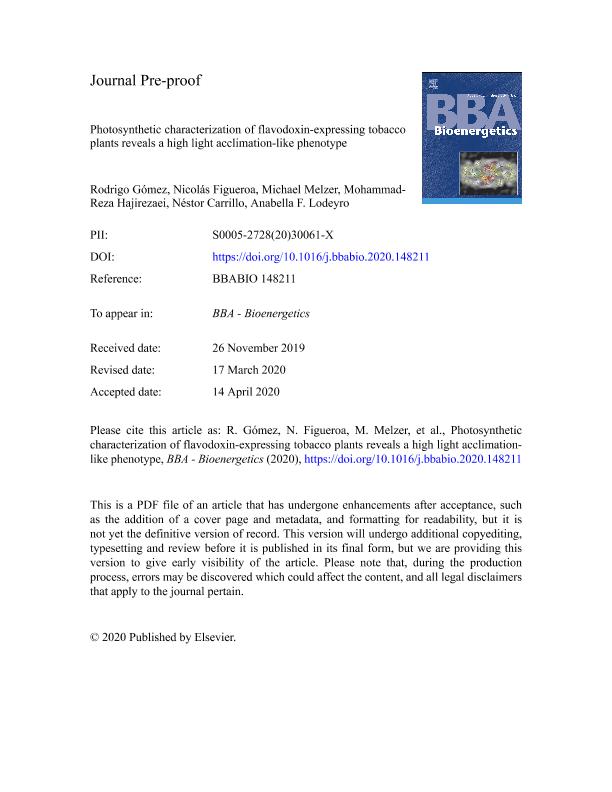Mostrar el registro sencillo del ítem
dc.contributor.author
Gomez, Rodrigo Lionel

dc.contributor.author
Figueroa, Nicolás Raúl

dc.contributor.author
Melzer, Michael
dc.contributor.author
Hajirezaei, Mohammad Reza
dc.contributor.author
Carrillo, Nestor Jose

dc.contributor.author
Lodeyro, Anabella Fernanda

dc.date.available
2023-01-10T10:50:11Z
dc.date.issued
2020-08
dc.identifier.citation
Gomez, Rodrigo Lionel; Figueroa, Nicolás Raúl; Melzer, Michael; Hajirezaei, Mohammad Reza; Carrillo, Nestor Jose; et al.; Photosynthetic characterization of flavodoxin-expressing tobacco plants reveals a high light acclimation-like phenotype; Elsevier Science; Biochimica Et Biophysica Acta-bioenergetics; 1861; 8; 8-2020; 1-34
dc.identifier.issn
0005-2728
dc.identifier.uri
http://hdl.handle.net/11336/184037
dc.description.abstract
Flavodoxins are electron carrier flavoproteins present in bacteria and photosynthetic microorganisms which duplicate the functional properties of iron-sulphur containing ferredoxins and replace them under adverse environmental situations that lead to ferredoxin decline. When expressed in plant chloroplasts, flavodoxin complemented ferredoxin deficiency and improved tolerance to multiple sources of biotic, abiotic and xenobiotic stress. Analysis of flavodoxin-expressing plants grown under normal conditions, in which the two carriers are present, revealed phenotypic effects unrelated to ferredoxin replacement. Flavodoxin thus provided a tool to alter the chloroplast redox poise in a customized way and to investigate its consequences on plant physiology and development. We describe herein the effects exerted by the flavoprotein on the function of the photosynthetic machinery. Pigment analysis revealed significant increases in chlorophyll a, carotenoids and chlorophyll a/b ratio in flavodoxin-expressing tobacco lines. Results suggest smaller antenna size in these plants, supported by lower relative contents of light-harvesting complex proteins. Chlorophyll a fluorescence and P700 spectroscopy measurements indicated that transgenic plants displayed higher quantum yields for both photosystems, a more oxidized plastoquinone pool under steady-state conditions and faster plastoquinone dark oxidation after a pulse of saturating light. Many of these effects resemble the phenotypes exhibited by leaves adapted to high irradiation, a most common environmental hardship faced by plants growing in the field. The results suggest that flavodoxin-expressing plants would be better prepared to cope with this adverse situation, and concur with earlier observations reporting that hundreds of stress-responsive genes were induced in the absence of stress in these lines.
dc.format
application/pdf
dc.language.iso
eng
dc.publisher
Elsevier Science

dc.rights
info:eu-repo/semantics/openAccess
dc.rights.uri
https://creativecommons.org/licenses/by-nc-nd/2.5/ar/
dc.subject
CHLOROPLAST
dc.subject
FLAVODOXIN
dc.subject
HIGH IRRADIATION
dc.subject
PHOTOSYNTHETIC ELECTRON TRANSPORT CHAIN
dc.subject
PLASTOQUINONE POOL
dc.subject
REDOX STATE
dc.subject.classification
Bioquímica y Biología Molecular

dc.subject.classification
Ciencias Biológicas

dc.subject.classification
CIENCIAS NATURALES Y EXACTAS

dc.title
Photosynthetic characterization of flavodoxin-expressing tobacco plants reveals a high light acclimation-like phenotype
dc.type
info:eu-repo/semantics/article
dc.type
info:ar-repo/semantics/artículo
dc.type
info:eu-repo/semantics/publishedVersion
dc.date.updated
2021-09-06T21:06:12Z
dc.journal.volume
1861
dc.journal.number
8
dc.journal.pagination
1-34
dc.journal.pais
Países Bajos

dc.journal.ciudad
Amsterdam
dc.description.fil
Fil: Gomez, Rodrigo Lionel. Consejo Nacional de Investigaciones Científicas y Técnicas. Centro Científico Tecnológico Conicet - Rosario. Instituto de Biología Molecular y Celular de Rosario. Universidad Nacional de Rosario. Facultad de Ciencias Bioquímicas y Farmacéuticas. Instituto de Biología Molecular y Celular de Rosario; Argentina
dc.description.fil
Fil: Figueroa, Nicolás Raúl. Consejo Nacional de Investigaciones Científicas y Técnicas. Centro Científico Tecnológico Conicet - Rosario. Instituto de Biología Molecular y Celular de Rosario. Universidad Nacional de Rosario. Facultad de Ciencias Bioquímicas y Farmacéuticas. Instituto de Biología Molecular y Celular de Rosario; Argentina
dc.description.fil
Fil: Melzer, Michael. Leibniz Institute Of Plant Genetics And Crop Plant Research.; Alemania
dc.description.fil
Fil: Hajirezaei, Mohammad Reza. Leibniz Institute Of Plant Genetics And Crop Plant Research.; Alemania
dc.description.fil
Fil: Carrillo, Nestor Jose. Consejo Nacional de Investigaciones Científicas y Técnicas. Centro Científico Tecnológico Conicet - Rosario. Instituto de Biología Molecular y Celular de Rosario. Universidad Nacional de Rosario. Facultad de Ciencias Bioquímicas y Farmacéuticas. Instituto de Biología Molecular y Celular de Rosario; Argentina
dc.description.fil
Fil: Lodeyro, Anabella Fernanda. Consejo Nacional de Investigaciones Científicas y Técnicas. Centro Científico Tecnológico Conicet - Rosario. Instituto de Biología Molecular y Celular de Rosario. Universidad Nacional de Rosario. Facultad de Ciencias Bioquímicas y Farmacéuticas. Instituto de Biología Molecular y Celular de Rosario; Argentina
dc.journal.title
Biochimica Et Biophysica Acta-bioenergetics

dc.relation.alternativeid
info:eu-repo/semantics/altIdentifier/url/https://linkinghub.elsevier.com/retrieve/pii/S000527282030061X
dc.relation.alternativeid
info:eu-repo/semantics/altIdentifier/doi/http://dx.doi.org/10.1016/j.bbabio.2020.148211
Archivos asociados
